-
All That Chatter Around Blue Bird Houses
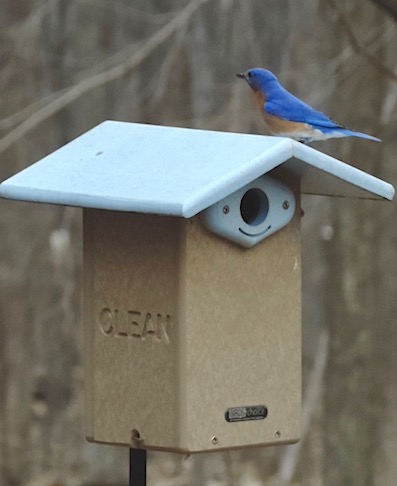 Lots of bluebird chatter recently and lots of chasing from feeders. It’s only January but in the southeast this activity means one thing… bluebirds are claiming their territories already!
Lots of bluebird chatter recently and lots of chasing from feeders. It’s only January but in the southeast this activity means one thing… bluebirds are claiming their territories already!The chattering along with the comical tip of the wing proves dad’s ready to find mom, pick the right blue bird house and get to work!
The previous family unit is severed and all bets are off now as juveniles are no longer welcome at meal worm feeders. Less than one full season old and it’s time to go find your own digs and significant other… they do grow up fast.
It’s difficult to watch sometimes, so you put extra meal worm feeders out and hope everyone gets a fair share. But instead, panic ensues and papa is frantically chasing his own offspring from feeder to feeder to feeder. Good grief!
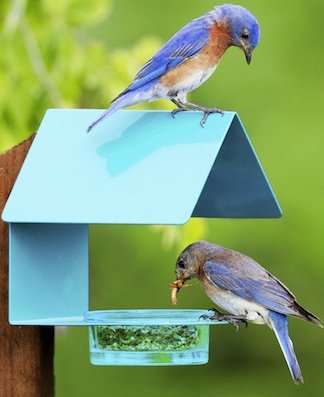
This is precisely why having more than one bluebird house within view of another doesn’t work. But one in front, one in back does seem to work peacefully. And it’s worth it because watching blues nest and raise their young is fascinating. And it goes on for months if the first clutch fledges successfully.
Two, three sometimes even four nests per season! That’s superb entertainment for up to 6 months if you’re in the southeast anyway.
Always remove nests after babies have fledged. Unlike some cavity nesting birds, bluebirds prefer to build a new clean nest for each brood. Promptly removing old nests opens up the birdhouse for their next clutch. Discard away from the birdhouse (like in the trash) as old nests on the ground or nearby will draw predators.
A couple of new blue bird house for spring:
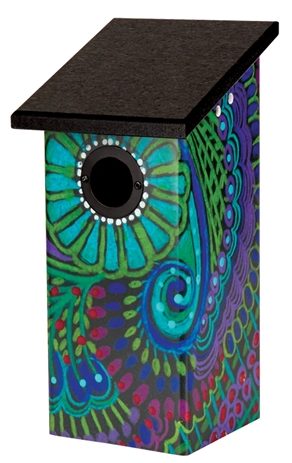
The Paisley Vinyl Bluebird House is whimsical garden decor with total functionality. Upgraded features make this one very bird friendly. Babies will love their fledgling ladder when it’s time to leave the nest!
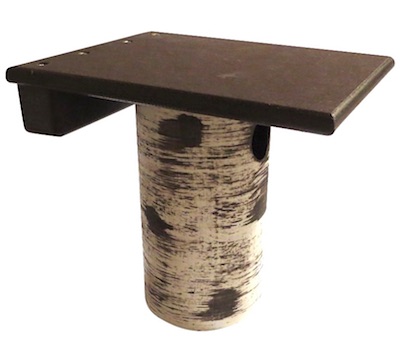 If you happen to be ready for the next level and wish to monitor your bluebirds’ progress (recommended) the popular Gilbertson Nest Box recently received a cool upgrade. An optional recycled plastic roof (poly-lumber) in matching brown looks perfect.
If you happen to be ready for the next level and wish to monitor your bluebirds’ progress (recommended) the popular Gilbertson Nest Box recently received a cool upgrade. An optional recycled plastic roof (poly-lumber) in matching brown looks perfect.The new roof coupled with its vinyl birch-like cavity will be around for many seasons. And tests were performed measuring ambient heat… the plastic roof keeps houses cooler in summer than the the original cedar roof. But for any die-hards out there… the original roof is still available.
C’mon spring and happy birding!
-
Blue Bird Houses Have Eggs for Easter
Mama Blue sure was busy the last few days. As of the previous nest check there were 0 eggs, but 4 today, an egg-stravaganza… like a special Easter gift!The whole episode started with a squabble between blues and chickadees over blue bird houses and who will nest where. Not uncommon at all for birds to remove others’ nesting material and raise a ruckus, but never had we seen activity like this before. Mr. Blue not only removed the moss from the birdhouse he wanted… he placed the material in a nearby house as if to say “okay, chickadee, you nest here!” The chickadee would then retrieve the moss Mr. Blue had placed inside! This activity went on for about 20 minutes until we were the ones who actually gave up!
Their nests are completely different, so the winner of choice number one box was confirmed the next day. Chickadees use moss, hair, feathers, and maybe wood chips, while Eastern bluebirds construct their nests with mostly pine needles, dried grasses or weeds. But no eggs, and a week later… no eggs 🙁 And then today 4 perfectly colored, beautiful bluebird eggs.
Not only in the Southeast, but as far north as IL and NY, bluebirds are starting earlier than usual.
Longer days and warmer temperatures have much to do with it. Availability of insects nudged the earlier than usual nest starts too. So as long as the weather cooperates (no snow/ice storms or drenching rains) bluebirds will be lucky to have a good season, with at least two, possibly three broods. Grow strong and thrive little blues!
Happy Easter to All…
May you find bluebird eggs in your house today!
-
Texas Rains and Blue Bird Houses Gone Wrong
In no way meant to diminish the extent of damage and loss from recent Texas floods, but being bird nerds, we wanted to convey the devastation at bird level too. Below the video is a devoted landlord’s heart breaking account of several days inside one of her blue bird houses.
The video below gives a good look at the Red River, check the panicked birds at 0.50. Possibly tens of thousands of cliff- and barn swallows were nesting under the three main bridges that succumbed to rising water, they lost homes and babies. Birds really do give us a glimpse of our changing environment.
“Well my first clutch did not work out well. I have a box in my yard, male and female came, made a nest and laid 6 eggs .
Everything was going great. Then the storms hit. The male disappeared and left Mama to tend to 4 that hatched. I provided meal worms in hopes to help her out.The rains just wouldn’t let up and she was having a very hard time getting any insects except the meal worms I provided. Then house sparrows came, even with a sparrow spooker, the female HOSP kept looking into the box. This prevented the Mom from leaving to hunt. I set a ground trap and did catch the pair. One bluebird nestling was dead in the nest. Then came home a few days later and a Red Tail Hawk was in the yard trying to get the house sparrow – needless to say mama blue was very upset and no telling how long she went without hunting that day.
Two days later another dead nestling. There were no signs of trauma but the nest was wet. I was forced to do a nest change and the remaining two were 16 days old. Two days later, after more torrential rains, another dead nestling. So I changed the nest again and tried to weather proof the house better. The storms were so severe that I figured that is why the last one didn’t fledge.
Yesterday I took the last one out and changed the nest again but noticed her wings were not normal. Only flight feathers and none of the smaller blood feathers (?) With help from the folks on Facebook, I found a rehab place. She lives in Ft. Worth and it’s about a 45 minute drive but I was going to take her the baby. She asked where I lived and she was surprised and said she was in Joshua now at the DQ!
I bundled up the nestling “stormy” and took her to the lady. She said it looked to be a nutritional problem and felt she will be able to save her! I took the box down, replaced the roof and new screws in where they were loose. Cleaned out the box real good and put it back. I know the mom is very upset, she is still calling this morning even through the storms 🙁 I feel so bad for her.”
Even those who don’t use blue bird houses are suffering heavy losses with downed trees and limbs and breaking snags.
Keith Kridler of Mt. Pleasant, Texas writes: “The reason Texas is having so much flooding is due to just how flat the Eastern half of the state is. Rivers are normally slow flowing nearly flat river bottoms with on average only one foot of fall or elevation change per one mile of river bed. Link below is to a short video of the Red River that flows between Oklahoma and Texas. Video is from last week and this bridge will go completely under water this weekend and or by Monday now. Notice in the one shot there appear to be hundreds if not thousands of Cliff Swallows flying in the air. These birds nest by the tens of thousands under these major bridges all across Texas. All three of the major bridges crossing the Red River between Texarkana and Paris Texas are thought to be going under water this weekend and or first of the week. Or about 100 miles from first to last bridge along the river. There are many videos of flooded bridges, watch for the numbers of swallows at each bridge.
I have counted as many as 1,000 Cliff Swallow nests under a single short span of highway overpass over a two lane farm to market road locally. Nearly all of the videos coming out of Texas are showing large flocks of Swallows circling these bridges and over passes that went under water. Barn Swallows and Cliff Swallows and also Eastern Phoebe’s nest in small road culverts that are normally dry in the summer. This summer most of these have gone under water multiple times. You sometimes find bluebirds, House Sparrows and other small species of cavity nesting birds that will nest in or on the left over swallow nests under these bridges and over passes.
Herds of wild hogs are getting pushed out of these river bottoms, deer now have small fawns and livestock are having to be moved upwards of a mile or further on some of the ranches to get above the flood waters. Any high ground near the river banks are swarming with stranded wildlife from snakes to bobcats. Anything that can climb a tree is hanging out in the tree tops.”
Mother nature can be brutal, but she is resilient. Mama blue and others will go on to nest again and raise their young. We hope for all of those who suffered damage and losses that this is soon and life regains a sense of normalcy.

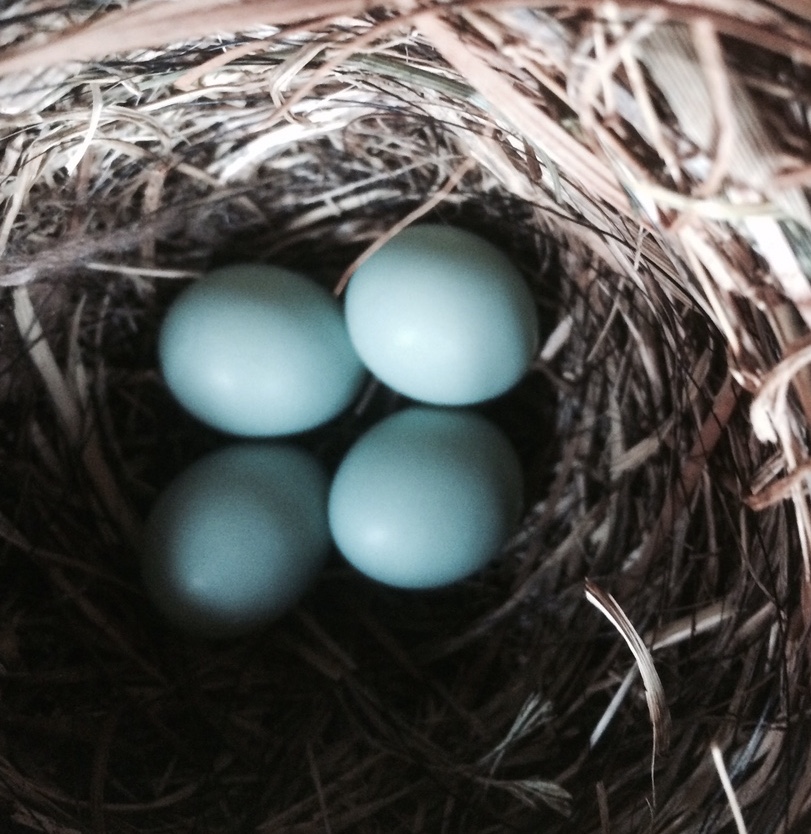
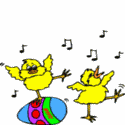 Longer days and warmer temperatures have much to do with it. Availability of insects nudged the earlier than usual nest starts too. So as long as the weather cooperates (no snow/ice storms or drenching rains) bluebirds will be lucky to have a good season, with at least two, possibly three broods. Grow strong and thrive little blues!
Longer days and warmer temperatures have much to do with it. Availability of insects nudged the earlier than usual nest starts too. So as long as the weather cooperates (no snow/ice storms or drenching rains) bluebirds will be lucky to have a good season, with at least two, possibly three broods. Grow strong and thrive little blues!